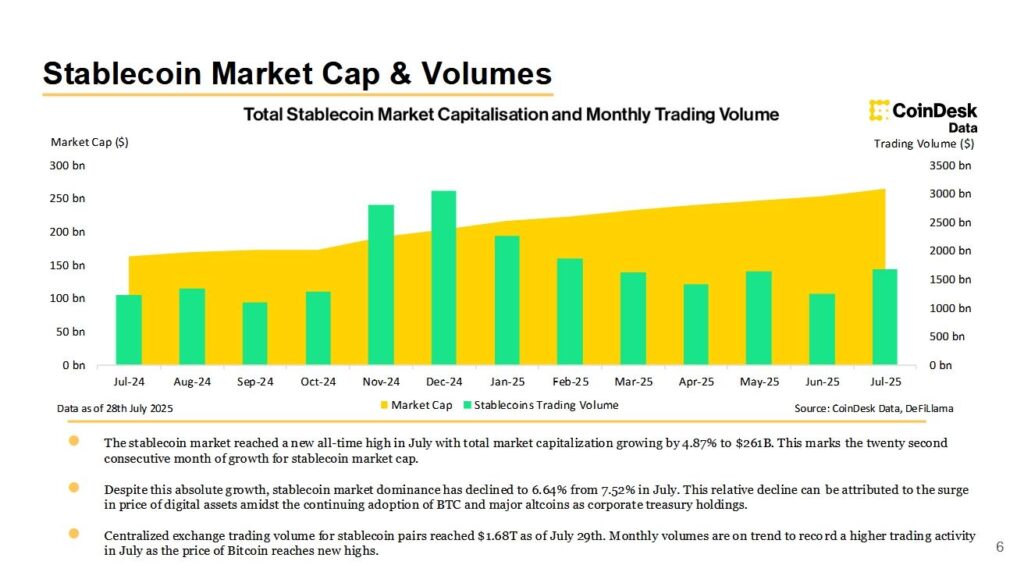Stablecoin Market Hits Record $261B Amid Regulatory Breakthrough
Stablecoin capitalization surged 4.87% in July, hitting an all-time high of $261 billion as regulatory clarity and institutional momentum reshape the digital dollar landscape.
In a landmark month for the digital asset ecosystem, the stablecoin market has extended its growth streak to 22 consecutive months, hitting a record $261 billion in total market capitalization in July, according to a report from Coindesk. This nearly 5% monthly increase, fueled by a wave of trading activity and growing institutional adoption, marks a significant milestone in the sector’s evolution from a niche crypto tool to a mainstream financial instrument.
The rally coincided with a broader crypto market upswing, bolstered by regulatory breakthroughs and increased corporate interest in blockchain-powered payment solutions. With stablecoin trading volume on centralized exchanges hitting $1.60 trillion in July alone, analysts say the sector is entering a new phase of legitimacy and utility.

Source: Coindesk Data
Tether and USDC Maintain Lead as Ethena and Falcon Surge
Tether (USDT), the long-standing market leader, continues to dominate the stablecoin space with a market cap of $164 billion, up 3.61% from the previous month. Despite this growth, USDT’s market share slipped slightly from 62.5% to 61.8%, reflecting increased competition from emerging players.
USD Coin (USDC), the second-largest stablecoin, posted a 3.78% rise to $63.6 billion, maintaining its role as a key instrument for institutional and DeFi use cases.
However, the most dramatic moves came from newer entrants:
- Ethena’s USDe surged 43.5% to reach $7.6 billion, even as its staking yield (APY) fell from over 20% to 9.79%, indicating sustained investor interest beyond incentive programs.
- Falcon Finance’s USDf delivered the month’s biggest percentage gain among top-10 stablecoins, rocketing 121% to $1.07 billion, a rise that caught many analysts off guard.
Meanwhile, some prominent stablecoins stumbled. BlackRock’s BUIDL fell 15.9% to $2.4 billion, and First Digital Labs’ FDUSD declined 8.54% to $8.54 billion, raising questions about sustainability and user confidence in newer offerings from legacy institutions.
Top 10 Stablecoins by Market Cap (as of July)
- Tether (USDT)
- USD Coin (USDC)
- Ethena USDe
- Sky Dollar
- DAI
- BlackRock USD (BUIDL)
- World Liberty Financial USD (USDD)
- Ethena USDtb
- First Digital USD
- Falcon USD
Tron Network Hits Milestone, Grabs 50% of USDT Supply
The Tron blockchain reached an all-time high stablecoin volume of $81.9 billion in July, a development that marks the first time since August 2024 that Tron controls more than 50% of all USDT in circulation across networks.
This rising dominance highlights Tron’s increasing role in the global stablecoin infrastructure, particularly in emerging markets and cross-border settlements where low fees and high throughput make it a preferred platform.
GENIUS Act Ushers in First Federal Stablecoin Rules
A major catalyst behind July’s growth was the signing of the GENIUS Act into U.S. law on July 18 by President Donald Trump, establishing the first comprehensive federal framework for “payment stablecoins.”
Under this landmark legislation, stablecoins must:
- Be fully backed 1:1 by cash or liquid U.S. Treasuries
- Disclose monthly reserve data
- Undergo regular third-party audits
These new requirements aim to bring transparency, consumer protection, and legitimacy to the sector. The move has already increased confidence among users and builders, encouraging traditional financial institutions and regulators globally to revisit their positions on stablecoin adoption.
For instance, in July, non-USD stablecoins such as euro- and ruble-backed tokens surpassed $1 billion in combined market cap for the first time—signaling demand for diversified fiat-backed assets.
Asia and Remittance Giants Move Toward Stablecoin Integration
Hong Kong regulators announced plans to license HKD- and CNY-pegged stablecoins for settlement purposes starting in 2026. This signals a shift away from USD-dominance in regional cross-border payments and aligns with China’s broader digital currency goals.
In a bold step aligning with China’s digital finance ambitions, Conflux Network unveiled plans to launch a yuan-backed stablecoin for international use, alongside a major network upgrade. The announcement, made at a Shanghai fintech conference and later published on the city’s official government portal, underscores growing institutional support for blockchain-driven cross-border payment solutions in Asia.
Just one day ago, Remitly, a major global remittance processor, revealed it will soon integrate stablecoins into its payment infrastructure, a move that could dramatically expand real-world utility for digital dollars.
Experts Divided on Long-Term Growth: $2T or $500B?
As the stablecoin market swells to new heights, industry experts are split on what lies ahead.
Brad Garlinghouse, CEO of Ripple, offered one of the most bullish forecasts in July during an appearance on CNBC’s “Squawk Box,” stating that the stablecoin market could scale to $2 trillion, driven by institutional momentum and evolving regulation.
Garlinghouse argued that stablecoins will become central to global payments, surpassing their current use in crypto trading and DeFi.
JPMorgan, however, is more cautious. The bank projects a stablecoin market of just $500 billion by 2028, warning that mainstream adoption remains limited, and use cases beyond trading are still narrow. The firm also noted the risk of regulatory fragmentation outside the U.S. and lack of demand from traditional banks as roadblocks to exponential growth.
A New Era of Stablecoins Begins
The combination of regulatory clarity, surging usage, and institutional integration signals that stablecoins are no longer just a crypto-native tool. They are increasingly viewed as a core pillar of the future financial system, with implications for monetary policy, global trade, and cross-border payments.
While forecasts may diverge, one trend is clear: stablecoins are evolving fast, and July’s data points to a market that is both maturing and expanding at a pace few predicted just a year ago. As innovation accelerates and policy frameworks stabilize, the sector is poised to play a defining role in reshaping how money moves across the internet.








